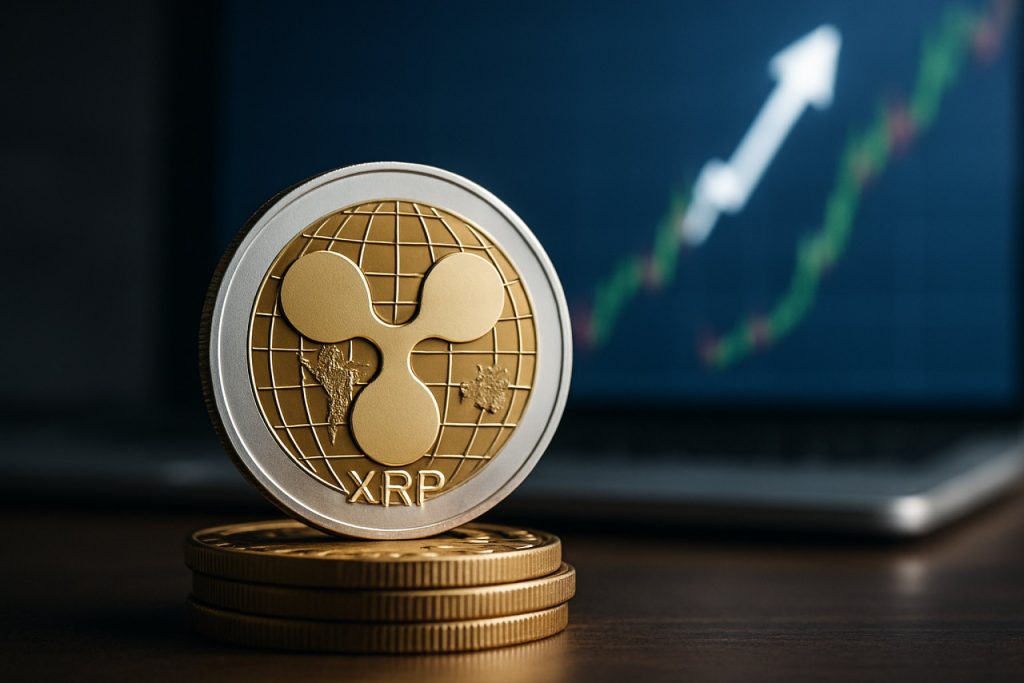
- XRP remains one of the most debated cryptocurrencies, driven by volatile price forecasts and a complex regulatory landscape.
- Optimistic analysts predict XRP could reach between $21.25 and $49 by 2030, offering potential for significant gains if adoption and partnerships strengthen.
- Bullish scenarios depend on XRP becoming a global payments solution, particularly in cross-border transactions and CBDCs.
- Bearish outlooks warn of regulatory setbacks and fierce competition, which could see XRP falling below $0.13 and investments shrinking dramatically.
- The XRP outlook is highly speculative; risk management and diversification are crucial for anyone considering an investment in digital assets.
No asset ignites so much debate among crypto enthusiasts as XRP. For years, it’s captured headlines, its swirling price projections matched only by its turbulent regulatory journey. Now, whispers about its future ripple louder, hinting at dramatic shifts that could either mint fortunes or fuel disappointment.
Today, with XRP dancing around $2.30, a $10,000 stake snags roughly 4,545 tokens. But what could this modest portfolio become, come 2030? While no one can say with certainty, multiple bold forecasts paint vivid scenarios—some dazzlingly optimistic, others soberingly cautious.
Signs Point to Big Gains—but With Huge Risks
Financial experts from established exchanges foresee potential winds of fortune. Some estimate XRP could soar as high as $21.25 within six years, bulked up by robust partnerships and real-world adoption. At these heights, those 4,545 tokens would balloon to nearly $96,590—a striking 9x leap.
Yet, the drumbeat grows louder from more bullish corners. Select analysts regard XRP as a candidate for digital gold status among cryptocurrencies. When conservative predictions push the price to almost $49, that same $10,000 investment could gush to a jaw-dropping $218,318 by the decade’s close. This vision hinges on XRP solidifying its place as a global payments backbone—a challenge, yet not an implausibility, especially as discussions around cross-border settlements and CBDCs intensify.
But What If the Tide Recedes?
Of course, cryptocurrencies cut both ways. Bearish camps highlight regulatory hurdles—like those faced by the U.S. Securities and Exchange Commission—and a crowded, evolving marketplace. Should the skeptics prove prescient, XRP may plummet to mere cents. If prices puncture $0.13, that $10,000 shrinks to a scant $590. Such gut-wrenching scenarios underscore why many caution against putting all eggs in a volatile basket.
Still, the most stratospheric dreams come from XRP die-hards who envision $100 or more per coin—a possibility that would catapult initial investments to nearly half a million dollars. While this gleams with promise, caution is prudent; even the most dynamic digital assets rarely follow a linear ascent.
Key Takeaway for Investors
The next decade for XRP pulses with uncertainty—wide-ranging predictions track everything from steep declines to once-in-a-lifetime windfalls. For would-be investors, the stakes are intoxicating, but the volatility is not for the faint of heart.
Prudent observers weigh the excitement with an old adage: never bet more than you can afford to lose. Whether XRP’s future scripts headlines of triumph or cautionary tales, it will serve as a vivid case study in the potential—and peril—of digital finance frontiers.
For those stepping into these volatile waters, focusing on in-depth research and spreading risk remains paramount. The unfolding XRP saga serves as a reminder: in crypto, fortunes can be made—or broken—in the blink of a digital eye.
To explore more about global markets and digital assets, browse the latest insights at Bloomberg and CoinDesk.
XRP Price Explosion or Bust? 2030 Predictions, Pros & Cons, and Must-Know Insights for Crypto Investors
# Deep Dive: Is XRP the Crypto Game-Changer of the Decade or a Bubble Waiting to Pop?
Unexplored Facts, Industry Trends, and Pressing Questions Answered
1. XRP: More Than Just a Cryptocurrency
What Is XRP and How Does It Really Work?
– XRP is both a digital asset and the native token of the XRP Ledger, an open-source, permissionless, and decentralized blockchain technology created by Ripple Labs.
– Unlike Bitcoin or Ethereum, the XRP Ledger doesn’t use energy-intensive mining to validate transactions. Instead, it uses a consensus protocol among validators, making it faster and more sustainable ([Ripple](https://ripple.com)).
– The average transaction on XRP settles in around 3-5 seconds, far surpassing traditional banking wires and even many other cryptocurrencies.
Global Partnerships – Going Beyond Hype
– Ripple, the main enterprise backer of XRP, has secured partnerships with over 300 global financial institutions, including Santander, SBI Holdings, and PNC Bank (source: [Ripple](https://ripple.com)).
– RippleNet offers On-Demand Liquidity (ODL) solutions powered by XRP, targeting multi-billion-dollar cross-border payment corridors.
—
2. How-To: Buying, Storing, and Using XRP Safely
Steps to Start with XRP in 2024
1. Choose a Regulated Exchange: Look for platforms like Coinbase, Kraken, or Bitstamp that support XRP and comply with your country’s regulations.
2. Secure a Wallet: Use hardware wallets like Ledger or Trezor, or trusted software wallets with private key control.
3. Enable Two-Factor Authentication: Strong security is vital given past exchange hacks.
4. Stay Updated: Follow official channels like [Coindesk](https://www.coindesk.com) for the latest in crypto regulations and tech developments.
Life Hack—Set Automated Alerts:
– Most exchanges let you set price alerts. Use these to track XRP’s major price movements to make better-timed decisions.
—
3. Market Forecasts & Industry Trends
What Are Experts Predicting for 2030?
– Bullish Trends: Experts at Credible Crypto and FXStreet envision XRP between $10 and $50 by 2030, contingent on mass adoption and favorable regulatory outcomes ([CoinDesk](https://www.coindesk.com)).
– Bearish Warnings: Regulatory headwinds, especially from the SEC’s litigation, could keep the price suppressed or volatile.
– CBDCs & Interoperability: Ripple is involved in multiple Central Bank Digital Currency pilots, including projects in Europe and Asia. Adoption of CBDCs can drive XRP’s utility if Ripple’s technology becomes the standard for cross-border transfers ([Bloomberg](https://www.bloomberg.com)).
—
4. Reviews & Comparisons
How Does XRP Stack Up Against Competing Cryptos?
– Speed: XRP processes ~1,500 transactions per second (TPS). Compare this to Bitcoin (7 TPS) and Ethereum (30 TPS, pre-ETH 2.0).
– Cost: Average XRP transaction fees are often less than a cent, among the lowest in crypto.
– Energy Efficiency: XRP’s consensus algorithm requires a tiny fraction of the energy compared to proof-of-work blockchains like Bitcoin.
Controversies & Limitations
– The ongoing SEC lawsuit alleging XRP as an unregistered security has led to US delistings and temporary suspensions on major platforms.
– Some question the degree of decentralization given Ripple’s significant initial ownership of XRP tokens.
—
5. Features, Specs, & Pricing
| Feature | XRP |
|——————-|—————————–|
| Speed | 3-5 seconds per transaction |
| Average Fee | < $0.01 |
| Maximum Supply | 100 billion XRP |
| Circulating Supply| ~54 billion XRP |
| Market Cap (2024) | ~$120 billion |
Security & Sustainability
– Strong track record with little or no history of double-spending or major protocol vulnerabilities.
– Low carbon footprint—a potential draw for ESG (Environmental, Social, Governance) investors.
—
6. Insights & Predictions
Will XRP Reach $100 by 2030?
– Most credible analysts consider $100 unlikely barring unprecedented adoption and a favorable end to SEC litigation.
– A realistic upside (if mass adoption occurs): $20–$50.
– Stark downside: Failure to resolve regulatory issues or loss of banking partnerships could sink XRP to sub-dollar levels.
—
7. Tutorials & Compatibility
How to Use XRP for Real-World Payments
– RippleNet’s growing adoption by banks enables near-instant remittance and B2B payments—to send money across borders at a fraction of traditional costs.
– XRP can be used as a bridge currency to convert between fiat pairs with limited liquidity.
—
8. Pros & Cons Overview
Pros
– Ultra-fast and low-cost transactions
– Supported by enterprise adoption
– Energy efficient
Cons
– Regulatory overhang (SEC court case)
– Competing solutions from central banks and new blockchains
– Risk of price suppression if adoption lags
—
9. Most Pressing Questions Answered
Is XRP a Good Investment in 2024?
– Only for those with a high risk tolerance—potential exists for strong gains, but volatility and legal risks are major concerns.
What Could Derail XRP’s Growth?
– Unfavorable outcome in SEC case, new disruptive technologies, or loss of institutional confidence could hurt its trajectory.
What’s the Safest Way to Hold XRP?
– Use reputable, regulated exchanges and cold storage hardware wallets; always enable 2FA and keep seed phrases offline.
—
Actionable Recommendations & Quick Tips
– Diversify. Consider XRP as a small portion of a broader crypto portfolio—never bet more than you can afford to lose.
– Stay Informed. Bookmark [Bloomberg](https://www.bloomberg.com), [Coindesk](https://www.coindesk.com), and the official [Ripple](https://ripple.com) blog for updates.
– Automate Alerts. Use in-app notifications to monitor price swings, especially given XRP’s volatility.
– Review Security. Regularly update wallet firmware and exchange security settings.
—
Final Word
XRP’s potential as a transformative financial bridge is real—but so are the headwinds. Approach investing with eyes wide open, prioritize security, and keep learning. In the world of crypto, knowledge is your most valuable asset.
—
Explore the pulse of the digital asset world at [Bloomberg](https://www.bloomberg.com) and [Coindesk](https://www.coindesk.com).



